A Review of Novel Heat Transfer Materials and Fluids for Aerospace Applications
Abstract
:1. Introduction
2. Thermal Control Applied in Aerospace
2.1. Aerospace Heat Transfer Equations and Dimensionless Groups
2.1.1. Ablation
2.1.2. Heat Transfer at High Speed
2.1.3. Rarefied Gas Heat Transfer
2.1.4. Cryogenic Heat Transfer
2.1.5. Microgravity Heat Transfer
2.2. Active Methods
2.2.1. ATCSs
2.2.2. Flow Boiling
2.2.3. Radiators
2.3. Passive Methods
2.3.1. Heat Pipe
2.3.2. Phase Change Materials (PCMs)
2.3.3. Pool Boiling
3. Nanomaterials Applied in Aerospace Thermal Control
3.1. Thermal Properties
3.2. Thermal Control Coatings
3.3. Thermal Protection Materials
4. Nanofluids
5. Conclusions and Future Perspectives
Author Contributions
Funding
Data Availability Statement
Conflicts of Interest
References
- Gilmore, D.G. Spacecraft Thermal Control Handbook, Volume I: Fundamental Technologies; AIAA: Reston, WV, USA, 2002. [Google Scholar]
- Hibbs, A.R. NASA Space Science Data Coordinated Archive. Available online: http://nssdc.gsfc.nasa.gov (accessed on 25 March 2024).
- Ali, H.M. Applications of combined/hybrid use of heat pipe and phase change materials in energy storage and cooling systems: A recent review. J. Energy Storage 2019, 26, 100986. [Google Scholar] [CrossRef]
- Alami, A.H.; Ramadan, M.; Tawalbeh, M.; Haridy, S.; Al Abdulla, S.; Aljaghoub, H.; Ayoub, M.; Alashkar, A.; Abdelkareem, M.A.; Olabi, A.G. A critical insight on nanofluids for heat transfer enhancement. Sci. Rep. 2023, 13, 15303. [Google Scholar] [CrossRef] [PubMed]
- Yang, Q.; Zhao, L.; Yu, H.; Min, Q.; Chen, C.; Zhou, D.; Yu, X.; Qiu, J.; Li, B.; Xu, X. UV-shielding device of high-stability glass embedded with in-situ growth of ZnO quantum dots. J. Alloys Compd. 2019, 784, 535–540. [Google Scholar] [CrossRef]
- Chen, J.; Yu, Y.; Feng, A.; Mi, L.; Xiu, H.; Yu, Y. Optical properties and radiation stability of SiO2/ZnO composite pigment prepared by co-sintering method. Ceram. Int. 2022, 48, 754–759. [Google Scholar] [CrossRef]
- Hu, C.; Zhang, H.; Neate, N.; Fay, M.; Hou, X.; Grant, D.; Xu, F. Highly Aligned Ni-Decorated GO–CNT Nanostructures in Epoxy with Enhanced Thermal and Electrical Properties. Polymers 2022, 14, 2583. [Google Scholar] [CrossRef] [PubMed]
- Leow, C.; Kreider, P.B.; Sommacal, S.; Kluth, P.; Compston, P. Electrical and thermal conductivity in graphene-enhanced carbon-fibre/PEEK: The effect of interlayer loading. Carbon 2023, 215, 118463. [Google Scholar] [CrossRef]
- Wang, S.; Cao, M.; Cong, F.; Xue, H.; Li, X.; Zhao, C.; Cui, X. Mechanical and thermal properties of graphene and carbon nanotube reinforced epoxy/boron nitride adhesives. J. Adhes. Sci. Technol. 2021, 35, 2142–2158. [Google Scholar] [CrossRef]
- Kong, D.; Li, H.; Gao, Y.; He, L.; Ji, X.; Zhang, F.; Li, W.; Zhang, H. Preparation and Characteristic of the Novel Multiple-Layer Thermal Insulation Nanocomposite Materials. ACS Sustain. Chem. Eng. 2023, 11, 11067–11076. [Google Scholar] [CrossRef]
- Wang, J.; Li, H.; Liu, H.; Feng, Z.; Cui, Z.; Liao, X.; Zhang, B.; Li, Q. Polar bear hair inspired ternary composite ceramic aerogel with excellent interfacial bonding and efficient infrared transmittance for thermal insulation. J. Eur. Ceram. Soc. 2023, 43, 4927–4938. [Google Scholar] [CrossRef]
- Kuprat, J.; van der Broeck, C.H.; Andresen, M.; Kalker, S.; Liserre, M.; De Doncker, R.W. Research on Active Thermal Control: Actual Status and Future Trends. IEEE J. Emerg. Sel. Top. Power Electron. 2021, 9, 6494–6506. [Google Scholar] [CrossRef]
- Calvert, M.J.; Baker, J. Micro-scale transport—Non-continuum thermophysical property variation effects on heat and momentum transfer. J. Thermophys. Heat Transf. 1998, 12, 138. [Google Scholar] [CrossRef]
- Tien, C.L.; Cunnington, G.R. Advances in Heat Transfer; Hartnett, J.P., Irvine, T.F., Eds.; Academic: New York, NY, USA, 1973. [Google Scholar]
- Zhao, L.; Rezkallah, K.S. Gas-liquid flow patterns at microgravity conditions. Int. J. Multiph. Flow 1993, 19, 751–763. [Google Scholar] [CrossRef]
- Xiong, Y.; Guo, L.; Huang, Y.; Chen, L.H. Intelligent Thermal Control Strategy Based on Reinforcement Learning for Space Telescope. J. Thermophys. Heat Transf. 2020, 34, 37–44. [Google Scholar] [CrossRef]
- NASA. Active Thermal Control System (ATCS) Overview; National Aeronautics and Space Administration (NASA): Washington, DC, USA, 2021. Available online: https://www.nasa.gov/wp-content/uploads/2021/02/473486main_iss_atcs_overview.pdf (accessed on 25 March 2024).
- Ungar, E.; Erickson, L. Assessment of the Use of Nanofluids in Spacecraft Active Thermal Control Systems. In AIAA SPACE 2011 Conference & Exposition; AIAA SPACE Forum; American Institute of Aeronautics and Astronautics: Reston, WV, USA, 2011. [Google Scholar]
- Wang, T.; Zhang, L.; Zhang, F.; Lu, Y. Reduction and reconstruction strategy of active thermal control system based on unsupervised learning and thermo-optics for spaceborne high-resolution remote sensor. Appl. Therm. Eng. 2023, 230, 120676. [Google Scholar] [CrossRef]
- Li, S.; Wang, Y.; Zhang, H.; Yu, F. Thermal Analysis and Validation of GF-4 Remote Sensing Camera. J. Therm. Sci. 2020, 29, 992–1000. [Google Scholar] [CrossRef]
- Meng, Q.; Wang, D.; Wang, X.; Li, W.; Yang, X.; Yan, D.; Li, Y.; Cao, Z.; Ji, Q.; Sun, T.; et al. High Resolution Imaging Camera (HiRIC) on China’s First Mars Exploration Tianwen-1 Mission. Space Sci. Rev. 2021, 217, 42. [Google Scholar] [CrossRef]
- Ortega, D.; Amador, A.; Ahmad, M.; Choudhuri, A.; Rahman, M.M. Liquid Nitrogen Flow Boiling Critical Heat Flux in Additively Manufactured Cooling Channels. Aerospace 2023, 10, 499. [Google Scholar] [CrossRef]
- Inoue, K.; Ohta, H.; Toyoshima, Y.; Asano, H.; Kawanami, O.; Imai, R.; Suzuki, K.; Shinmoto, Y.; Matsumoto, S. Heat Loss Analysis of Flow Boiling Experiments Onboard International Space Station with Unclear Thermal Environmental Conditions (1st Report: Subcooled Liquid Flow Conditions at Test Section Inlet). Microgravity Sci. Technol. 2021, 33, 28. [Google Scholar] [CrossRef]
- Devahdhanush, V.S.; Darges, S.J.; Mudawar, I.; Nahra, H.K.; Balasubramaniam, R.; Hasan, M.M.; Mackey, J.R. Flow visualization, heat transfer, and critical heat flux of flow boiling in Earth gravity with saturated liquid-vapor mixture inlet conditions—In preparation for experiments onboard the International Space Station. Int. J. Heat Mass Transf. 2022, 192, 122890. [Google Scholar] [CrossRef]
- Mudawar, I.; Lee, J. Experimental and computational investigation into hydrodynamic and heat transfer characteristics of subcooled flow boiling on the International Space Station. Int. J. Heat Mass Transf. 2023, 207, 124000. [Google Scholar] [CrossRef]
- Han, Z.; Zhang, J.; Wang, M.; Tian, W.; Qiu, S.; Su, G.H. A modified system analysis code for thermo-hydraulic calculation of hydrogen in a nuclear thermal propulsion (NTP) system. Ann. Nucl. Energy 2021, 164, 108632. [Google Scholar] [CrossRef]
- Zhang, Y.-N.; Zhang, H.-C.; Zhang, X.; Yu, H.-X.; Zhao, G.-B. Block Radial Basis Function Collocation Meshless method applied to steady and transient neutronics problem solutions in multi-material reactor cores. Prog. Nucl. Energy 2018, 109, 83–96. [Google Scholar] [CrossRef]
- El-Genk, M.S. Space nuclear reactor power system concepts with static and dynamic energy conversion. Energy Convers. Manag. 2008, 49, 402–411. [Google Scholar] [CrossRef]
- Lee, K.-L.; Tarau, C.; Anderson, W.G.; Beard, D. Titanium-Water Heat Pipe Radiators for Space Fission Power System Thermal Management. Microgravity Sci. Technol. 2020, 32, 453–464. [Google Scholar] [CrossRef]
- Li, Z.; Zhang, H.; Huang, Z.; Zhang, D.; Wang, H. Characteristics and optimation of heat pipe radiator for space nuclear propulsion spacecraft. Prog. Nucl. Energy 2022, 150, 104307. [Google Scholar] [CrossRef]
- Zhao, C.; Huang, Y.; Wang, J. Solid particle radiator systems for heat rejection in space. J. Phys. Conf. Ser. 2021, 1777, 012054. [Google Scholar] [CrossRef]
- Kianfar, K.; Joodaki, S.; Dashti, I.; Asghari, S. Lifetime estimation of heat pipes in space applications using particle filtering, Arrhenius and FIDES methods. Therm. Sci. Eng. Prog. 2021, 22, 100847. [Google Scholar] [CrossRef]
- Mohamed, H.A.E.; Ezzaldeen, E. Heat Pipes for Computer Cooling Applications. In Electronics Cooling; Murshed, S.M.S., Ed.; IntechOpen: Rijeka, Republic of Croatia, 2016; Chapter 4. [Google Scholar]
- Senthil, R.; Madurai Elavarasan, R.; Pugazhendhi, R.; Premkumar, M.; Vengadesan, E.; Navakrishnan, S.; Islam, M.R.; Natarajan, S.K. A holistic review on the integration of heat pipes in solar thermal and photovoltaic systems. Sol. Energy 2021, 227, 577–605. [Google Scholar] [CrossRef]
- Shukla, K. Heat Pipe for Aerospace Applications—An Overview. J. Electron. Cool. Therm. Control. 2015, 5, 1–14. [Google Scholar] [CrossRef]
- Mock, P.R.; Marcus, D.B.; Edelman, E.A. Communications Technology Satellite: A Variable Conductance Heat Pipe Application. J. Spacecr. Rocket. 1975, 12, 750–753. [Google Scholar] [CrossRef]
- Kim, T.Y.; Hyun, B.-S.; Lee, J.-J.; Rhee, J. Numerical study of the spacecraft thermal control hardware combining solid–liquid phase change material and a heat pipe. Aerosp. Sci. Technol. 2013, 27, 10–16. [Google Scholar] [CrossRef]
- Zhao, X.; Su, L.; Jiang, J.; Deng, W.; Zhao, D. A Review of Working Fluids and Flow State Effects on Thermal Performance of Micro-Channel Oscillating Heat Pipe for Aerospace Heat Dissipation. Aerospace 2023, 10, 179. [Google Scholar] [CrossRef]
- Ababneh, M.T.; Tarau, C.; Anderson, W.G.; Farmer, J.T.; Hawkins, R.; Alvarez-Hernandez, A.R.; Ortega, S.; Fisher, J.W. Copper-Water and Hybrid Aluminum-Ammonia Heat Pipes for Spacecraft Thermal Control Applications. In Proceedings of the International Heat Pipe Symposium (IHPS), Pisa, Italy, 10–14 June 2018. [Google Scholar]
- Hu, L.; Chen, Z.; Shi, K.; Shi, J.; Luo, X.; Liu, C. Sodium/GH4099 Heat Pipes for Space Reactor Cooling. Microgravity Sci. Technol. 2021, 33, 60. [Google Scholar] [CrossRef]
- Mameli, M.; Araneo, L.; Filippeschi, S.; Marelli, L.; Testa, R.; Marengo, M. Thermal response of a closed loop pulsating heat pipe under a varying gravity force. Int. J. Therm. Sci. 2014, 80, 11–22. [Google Scholar] [CrossRef]
- Ando, M.; Okamoto, A.; Tanaka, K.; Maeda, M.; Sugita, H.; Daimaru, T.; Nagai, H. On-orbit demonstration of oscillating heat pipe with check valves for space application. Appl. Therm. Eng. 2018, 130, 552–560. [Google Scholar] [CrossRef]
- Ayel, V.; Araneo, L.; Marzorati, P.; Romestant, C.; Bertin, Y.; Marengo, M. Visualization of Flow Patterns in Closed Loop Flat Plate Pulsating Heat Pipe Acting as Hybrid Thermosyphons under Various Gravity Levels. Heat Transf. Eng. 2019, 40, 227–237. [Google Scholar] [CrossRef]
- Pereira, J.; Souza, R.; Moreira, A.; Moita, A. A Review on the Nanofluids-PCMs Integrated Solutions for Solar Thermal Heat Transfer Enhancement Purposes. Technologies 2023, 11, 166. [Google Scholar] [CrossRef]
- Torres-Rodríguez, A.; Morillón-Gálvez, D.; Aldama-Ávalos, D.; Hernández-Gómez, V.H.; García Kerdan, I. Thermal performance evaluation of a passive building wall with CO2-filled transparent thermal insulation and paraffin-based PCM. Sol. Energy 2020, 205, 1–11. [Google Scholar] [CrossRef]
- Khadem, Z.; Salari, A.; Naghdbishi, A.; Shakibi, H.; Sardarabadi, M. Parametric analysis of a PCM-based heat sink for electronic device thermal management. J. Energy Storage 2023, 74, 109118. [Google Scholar] [CrossRef]
- Collette, J.; Rochus, P.; Peyrou-Lauga, R.; Pin, O.; Nutal, N.; Larnicol, M.; Crahay, J. Phase change material device for spacecraft thermal control. In Proceedings of the 62nd International Astronautical Congress 2011, IAC 2011, Cape Town, South Africa, 3–7 October 2011; International Astronautical Federation: Paris, France, 2011; Volume 7, pp. 6020–6031. [Google Scholar]
- Huibin, Y.; Xuenong, G.; Jing, D. Cooling technology of electronic device based on phase-change material with rapid thermal response. J. South Chin. Univ. Technol. (Nat. Sci. Ed.) 2007, 35, 52–56. [Google Scholar]
- Lafdi, K.; Mesalhy, O.; Elgafy, A. Graphite foams infiltrated with phase change materials as alternative materials for space and terrestrial thermal energy storage applications. Carbon 2008, 46, 159–168. [Google Scholar] [CrossRef]
- He, Y.; Tao, Y.B.; Zhao, C.Y.; Yu, X.K. Structure parameter analysis and optimization of photovoltaic-phase change material-thermoelectric coupling system under space conditions. Renew. Energy 2022, 200, 320–333. [Google Scholar] [CrossRef]
- Borshchak Kachalov, A.; Salgado Sánchez, P.; Martínez, U.; Ezquerro, J.M. Preliminary Design of a Space Habitat Thermally Controlled Using Phase Change Materials. Thermo 2023, 3, 232–247. [Google Scholar] [CrossRef]
- Garmendia, I.; Vallejo, H.; Seco, M.; Anglada, E. Design and Fabrication of a Phase Change Material Heat Storage Device for the Thermal Control of Electronics Components of Space Applications. Aerospace 2022, 9, 126. [Google Scholar] [CrossRef]
- Zmywaczyk, J.; Zbińkowski, P.; Koniorczyk, P. Thermophysical Properties of POLWAX LTP ST Paraffin Doped with or without Carbon Nanotubes or Silver Nanowires and Passive Cooling of a High-Power LED Panel. Energies 2023, 16, 6068. [Google Scholar] [CrossRef]
- Khan, Z.; Khan, Z.A. Experimental and numerical investigations of nano-additives enhanced paraffin in a shell-and-tube heat exchanger: A comparative study. Appl. Therm. Eng. 2018, 143, 777–790. [Google Scholar] [CrossRef]
- Krishna, J.; Kishore, P.S.; Solomon, A.B. Heat pipe with nano enhanced-PCM for electronic cooling application. Exp. Therm. Fluid Sci. 2017, 81, 84–92. [Google Scholar] [CrossRef]
- Attinger, D.; Frankiewicz, C.; Betz, A.R.; Schutzius, T.M.; Ganguly, R.; Das, A.; Kim, C.-J.; Megaridis, C.M. Surface engineering for phase change heat transfer: A review. MRS Energy Sustain. 2014, 1, 4. [Google Scholar] [CrossRef]
- Nukiyama, S. The maximum and minimum values of the heat Q transmitted from metal to boiling water under atmospheric pressure. Int. J. Heat Mass Transf. 1966, 9, 1419–1433. [Google Scholar] [CrossRef]
- Kondo, M.; Matsumoto, J. Surface tension and wettability calculation using density gradient potential in a physically consistent particle method. Comput. Methods Appl. Mech. Eng. 2021, 385, 114072. [Google Scholar] [CrossRef]
- Garivalis, A.I.; Manfredini, G.; Saccone, G.; Di Marco, P.; Kossolapov, A.; Bucci, M. Critical heat flux enhancement in microgravity conditions coupling microstructured surfaces and electrostatic field. npj Microgravity 2021, 7, 37. [Google Scholar] [CrossRef] [PubMed]
- Dhir, V.K.; Warrier, G.R.; Aktinol, E.; Chao, D.; Eggers, J.; Sheredy, W.; Booth, W. Nucleate Pool Boiling Experiments (NPBX) on the International Space Station. Microgravity Sci. Technol. 2012, 24, 307–325. [Google Scholar] [CrossRef]
- Quintana-Buil, G.; González-Cinca, R. Acoustic effects on heat transfer on the ground and in microgravity conditions. Int. J. Heat Mass Transf. 2021, 178, 121627. [Google Scholar] [CrossRef]
- Moehrle, R.E.; Chung, J.N. Pool boiling heat transfer driven by an acoustic standing wave in terrestrial gravity and microgravity. Int. J. Heat Mass Transf. 2016, 93, 322–336. [Google Scholar] [CrossRef]
- Zhang, Y.; Zhao, J.; Wei, J.; Xue, Y. Nucleate Pool Boiling Heat Transfer on a Micro-Pin-Finned Surface in Short-Term Microgravity. Heat Transf. Eng. 2017, 38, 594–610. [Google Scholar] [CrossRef]
- Zhang, Y.; Wei, J.; Xue, Y.; Kong, X.; Zhao, J. Bubble dynamics in nucleate pool boiling on micro-pin-finned surfaces in microgravity. Appl. Therm. Eng. 2014, 70, 172–182. [Google Scholar] [CrossRef]
- Gajanan, K.; Tijare, S.N. Applications of nanomaterials. Mater. Today Proc. 2018, 5 Pt 1, 1093–1096. [Google Scholar] [CrossRef]
- Pathak, S.; Saha, G.C.; Abdul Hadi, M.B.; Jain, N.K. Engineered Nanomaterials for Aviation Industry in COVID-19 Context: A Time-Sensitive Review. Coatings 2021, 11, 382. [Google Scholar] [CrossRef]
- Hu, C.; Liu, T.; Neate, N.; Fay, M.; Hou, X.; Grant, D.; Xu, F. Enhanced thermal and electrical properties by Ag nanoparticles decorated GO–CNT nanostructures in PEEK composites. Compos. Sci. Technol. 2022, 218, 109201. [Google Scholar] [CrossRef]
- Farzanehfar, N.; Taheri, A.; Rafiemanzelat, F.; Jazani, O.M. High-performance epoxy nanocomposite adhesives with enhanced mechanical, thermal and adhesion properties based on new nanoscale ionic materials. Chem. Eng. J. 2023, 471, 144428. [Google Scholar] [CrossRef]
- Kaveh, A.; Moini Jazani, O.; Fallahi, M.; Asghari, S.; Mirmohammadi, S.M.; Hajizamani, E.; Taghavi, M.R.; Namvar Asl, A. Introducing a new approach for designing advanced epoxy film adhesives with high mechanical, adhesion, and thermal properties by adding hybrid additives for structural bonding. Colloids Surf. A Physicochem. Eng. Asp. 2023, 676, 132180. [Google Scholar] [CrossRef]
- Shekar, R.I.; Kotresh, T.M.; Rao, P.M.D.; Kumar, K. Properties of high modulus PEEK yarns for aerospace applications. J. Appl. Polym. Sci. 2009, 112, 2497–2510. [Google Scholar] [CrossRef]
- Akibul Islam, M.; Chowdhury, M.A.; Arefin Kowser, M.; Osman Ali, M.; Azad, K.; Ramjan Ali, M. Enhancement of thermal properties of Kevlar 29 coated by SiC and TiO2 nanoparticles and their binding energy analysis. Arab. J. Chem. 2022, 15, 103959. [Google Scholar] [CrossRef]
- Azad, M.M.; Ejaz, M.; Shah, A.U.R.; Afaq, S.K.; Song, J.-I. A bio-based approach to simultaneously improve flame retardancy, thermal stability and mechanical properties of nano-silica filled jute/thermoplastic starch composite. Mater. Chem. Phys. 2022, 289, 126485. [Google Scholar] [CrossRef]
- Delfini, A.; Pastore, R.; Santoni, F.; Piergentili, F.; Albano, M.; Alifanov, O.; Budnik, S.; Morzhukhina, A.; Nenarokomov, A.; Titov, D. Thermal analysis of advanced plate structures based on ceramic coating on carbon/carbon substrates for aerospace Re-Entry Re-Useable systems. Acta Astronaut. 2021, 183, 153–161. [Google Scholar] [CrossRef]
- Wang, Y.; Ba, F.; Chai, Z.; Zhang, Z. A review of thermal control coatings prepared by micro-arc oxidation on light alloys. Int. J. Electrochem. Sci. 2024, 19, 100514. [Google Scholar] [CrossRef]
- Peltier, F.; Thierry, D. Review of Cr-Free Coatings for the Corrosion Protection of Aluminum Aerospace Alloys. Coatings 2022, 12, 518. [Google Scholar] [CrossRef]
- Zareanshahraki, F.; Asemani, H.R.; Skuza, J.; Mannari, V. Synthesis of non-isocyanate polyurethanes and their application in radiation-curable aerospace coatings. Prog. Org. Coat. 2020, 138, 105394. [Google Scholar] [CrossRef]
- Chen, G.; Wang, Y.; Qiu, J.; Cao, J.; Zou, Y.; Wang, S.; Jia, D.; Zhou, Y. Robust Inorganic Daytime Radiative Cooling Coating Based on a Phosphate Geopolymer. ACS Appl. Mater. Interfaces 2020, 12, 54963–54971. [Google Scholar] [CrossRef]
- Sharma, A.K. Surface engineering for thermal control of spacecraft. Surf. Eng. 2005, 21, 249–253. [Google Scholar] [CrossRef]
- Mikhailov, M.; Yuryev, S.; Lapin, A.; Goronchko, V. Reflective thermal control coating for spacecraft based on ZnO pigment and Li2SiO3 silicate modified by SiO2 nanoparticles. Ceram. Int. 2023, 49, 20817–20821. [Google Scholar] [CrossRef]
- Chen, H.; Li, P.; Zhou, H.; Zhang, W.; Cong, L.; Ma, J. Full solar-spectral reflectance of ZnO QDs/SiO2 composite pigment for thermal control coating. Mater. Res. Bull. 2022, 146, 111572. [Google Scholar] [CrossRef]
- Chen, M.; Pang, D.; Chen, X.; Yan, H.; Yang, Y. Passive daytime radiative cooling: Fundamentals, material designs, and applications. EcoMat 2022, 4, e12153. [Google Scholar] [CrossRef]
- Liu, J.; Zhou, Z.; Zhang, D.; Jiao, S.; Zhang, J.; Gao, F.; Ling, J.; Feng, W.; Zuo, J. Research on the performance of radiative cooling and solar heating coupling module to direct control indoor temperature. Energy Convers. Manag. 2020, 205, 112395. [Google Scholar] [CrossRef]
- Alimohammadian, M.; Dinarvand, S. Enhancement of passive daytime radiative cooling performance with a novel hybrid strategy of integrating double-layer nanoparticle-based coating and ballistic thermal rectifier. J. Therm. Anal. Calorim. 2023, 148, 7995–8007. [Google Scholar] [CrossRef]
- Kang, H.-K. Microstructure and electrical conductivity of high volume Al2O3-reinforced copper matrix composites produced by plasma spray. Surf. Coat. Technol. 2005, 190, 448–452. [Google Scholar] [CrossRef]
- Bolelli, G.; Cannillo, V.; Lugli, C.; Lusvarghi, L.; Manfredini, T. Plasma-sprayed graded ceramic coatings on refractory materials for improved chemical resistance. J. Eur. Ceram. Soc. 2006, 26, 2561–2579. [Google Scholar] [CrossRef]
- Sachidananda, K.B.; Mahesha, K.; Dey, A. Effect of powder particle size on vibration damping behaviour of plasma sprayed alumina (Al2O3) coating on AISI 304 stainless steel substrate. Ceram. Int. 2018, 44, 158–163. [Google Scholar] [CrossRef]
- Gangil, N.; Siddiquee, A.N.; Maheshwari, S. Aluminium based in-situ composite fabrication through friction stir processing: A review. J. Alloys Compd. 2017, 715, 91–104. [Google Scholar] [CrossRef]
- He, G.; Guo, W.; He, D.; Zhang, J.; Xing, Z.; Lv, Z.; Jia, L.; Huang, Y. Study of the Mechanical Properties and Thermal Control Performance of Plasma-Sprayed Alumina Coating on Aluminum Alloy Surface. Appl. Sci. 2023, 13, 956. [Google Scholar] [CrossRef]
- Gogu, C.; Bapanapalli, S.K.; Haftka, R.T.; Sankar, B.V. Comparison of Materials for an Integrated Thermal Protection System for Spacecraft Reentry. J. Spacecr. Rocket. 2009, 46, 501–513. [Google Scholar] [CrossRef]
- Allen, H.J. Hypersonic Flight and the Re-Entry Problem: The Twenty-First Wright Brothers Lecture. J. Aerosp. Sci. 1958, 25, 217–227. [Google Scholar] [CrossRef]
- Sutton, G.P.; Biblarz, O. Rocket Propulsion Elements.; John Wiley & Sons: Hoboken, NJ, USA, 2016. [Google Scholar]
- Favaloro, M. Ablative Materials. Kirk-Othmer Encyclopedia of Chemical Technology, Wiley Online Library: Hoboken, NJ, USA, 2000. [Google Scholar] [CrossRef]
- Park, S.-J.; Seo, M.-K. Chapter 7—Types of Composites. In Interface Science and Technology; Park, S.-J., Seo, M.-K., Eds.; Elsevier: Amsterdam, The Netherlands, 2011; Volume 18, pp. 501–629. [Google Scholar]
- Kausar, A. Polymeric Nanocomposites with Carbonaceous Nanofillers for Aerospace Applications; Woodhead Publishing Series in Composites Science and Engineering: Cambridge, UK, 2022. [Google Scholar]
- Yuan, S.; Shen, F.; Chua, C.K.; Zhou, K. Polymeric composites for powder-based additive manufacturing: Materials and applications. Prog. Polym. Sci. 2019, 91, 141–168. [Google Scholar] [CrossRef]
- Öztürkmen, M.B.; Özkutlu Demirel, M.; Ağaç, Ö.; Ece, R.E.; Öz, Y. Tailored multifunctional nanocomposites obtained by integration of carbonaceous fillers in an aerospace grade epoxy resin curing at high temperatures. Diam. Relat. Mater. 2023, 135, 109840. [Google Scholar] [CrossRef]
- Tate, J.S.; Gaikwad, S.; Theodoropoulou, N.; Trevino, E.; Koo, J.H. Carbon/Phenolic Nanocomposites as Advanced Thermal Protection Material in Aerospace Applications. J. Compos. 2013, 2013, 403656. [Google Scholar] [CrossRef]
- Ahmad, S.; Ali, S.; Salman, M.; Baluch, A.H. A comparative study on the effect of carbon-based and ceramic additives on the properties of fiber reinforced polymer matrix composites for high temperature applications. Ceram. Int. 2021, 47, 33956–33971. [Google Scholar] [CrossRef]
- Tran, H.K.; Rasky, D.J.; Esfahani, L. Thermal response and ablation characteristics of lightweight ceramic ablators. J. Spacecr. Rocket. 1994, 31, 993–998. [Google Scholar] [CrossRef]
- Kubota, Y.; Miyamoto, O.; Aoki, T.; Ishida, Y.; Ogasawara, T.; Umezu, S. New thermal protection system using high-temperature carbon fibre-reinforced plastic sandwich panel. Acta Astronaut. 2019, 160, 519–526. [Google Scholar] [CrossRef]
- Jin, X.; Liu, C.; Huang, H.; Pan, R.; Wu, C.; Yan, X.; Wang, H.; Pan, Y.; Hong, C.; Zhang, X. Multiscale, elastic, and low-density carbon fibre/siliconoxycarbide-phenolic interpenetrating aerogel nanocomposite for ablative thermal protection. Compos. Part B Eng. 2022, 245, 110212. [Google Scholar] [CrossRef]
- Zhou, Y.; Yin, S.; Zhou, Q.; Chen, Z.; Xue, L.; Li, H.; Yan, Y. Improving high temperature properties of Cu-Cr-Y alloy by residual Cr particles and nano-Y2O3 dispersions. J. Mater. Res. Technol. 2022, 21, 2976–2988. [Google Scholar] [CrossRef]
- Wang, Z.; Cheng, Z.; Jiao, X.; Chen, D.; Wang, T. Formation of SiO2-Encapsulated Ag Nanoparticles on SiO2 Nanofibers and Their Application as Robust, Flexible Pressure Sensor Working under High Temperatures. ACS Appl. Nano Mater. 2023, 6, 6112–6120. [Google Scholar] [CrossRef]
- Rahman, M.H.; Chowdhury, E.H.; Hong, S. High temperature oxidation of monolayer MoS2 and its effect on mechanical properties: A ReaxFF molecular dynamics study. Surf. Interfaces 2021, 26, 101371. [Google Scholar] [CrossRef]
- Martin, K.L.; Clarkson, C.M.; Thompson, C.; Germanton, G.; Posey, N.; Wiegart, L.; Ramakrishnan, S.; Dickerson, M.B. Influence of Thermal Treatment on Preceramic Polymer Grafted Nanoparticle Network Formation: Implications for Thermal Protection Systems and Aerospace Propulsion Components. ACS Appl. Nano Mater. 2022, 5, 15288–15297. [Google Scholar] [CrossRef]
- Das, S.K.; Choi, S.U.; Yu, W.; Pradeep, T. Nanofluids: Science and Technology; John Wiley & Sons: Hoboken, NJ, USA, 2008. [Google Scholar]
- Kuo, K.K.; Risha, G.A.; Evans, B.J.; Boyer, E. Potential Usage of Energetic Nano-sized Powders for Combustion and Rocket Propulsion. MRS Online Proc. Libr. 2003, 800, 39–50. [Google Scholar] [CrossRef]
- Yanaoka, H.; Inafune, R. Frequency response of three-dimensional natural convection of nanofluids under microgravity environments with gravity modulation. Numer. Heat Transf. Part A Appl. 2023, 83, 745–769. [Google Scholar] [CrossRef]
- Mohammed, H.I.; Giddings, D.; Walker, G.S.; Talebizadehsardari, P.; Mahdi, J.M. Thermal behaviour of the flow boiling of a complex nanofluid in a rectangular channel: An experimental and numerical study. Int. Commun. Heat Mass Transf. 2020, 117, 104773. [Google Scholar] [CrossRef]
- Chen, Y.; Li, X.; Fang, X.; He, Z.; Fang, Y. Experimental Investigation of Critical Heat Flux of Nucleate Pool Boiling of Water and Nanofluid on Platinum Wire Under Hypergravity and Earth Gravity. Microgravity Sci. Technol. 2023, 35, 61. [Google Scholar] [CrossRef]
- Arif, M.; Kumam, P.; Kumam, W.; Mostafa, Z. Heat transfer analysis of radiator using different shaped nanoparticles water-based ternary hybrid nanofluid with applications: A fractional model. Case Stud. Therm. Eng. 2022, 31, 101837. [Google Scholar] [CrossRef]
- Henein, S.M.; Abdel-Rehim, A.A. The performance response of a heat pipe evacuated tube solar collector using MgO/MWCNT hybrid nanofluid as a working fluid. Case Stud. Therm. Eng. 2022, 33, 101957. [Google Scholar] [CrossRef]
- Wu, W.-C.; Kumar, A. Numerical Investigation of Nanofluid Flow over a Backward Facing Step. Aerospace 2022, 9, 499. [Google Scholar] [CrossRef]
- Chen, C.; Feng, S.; Peng, H.; Peng, X.; Chaoyue, L.; Zhang, R. Thermocapillary Convection Flow and Heat Transfer Characteristics of Graphene Nanoplatelet Based Nanofluid Under Microgravity. Microgravity Sci. Technol. 2021, 33, 40. [Google Scholar] [CrossRef]
- Zhang, B.; Tang, L.; Zhang, H.; Ali, B.; Shah, N.A.; Jeon, Y. Finite element study of nanoparticles spacing and radius on dynamics of water fluid subject to microgravity environment. Results Phys. 2023, 47, 106355. [Google Scholar] [CrossRef]
- Dong, S.; Jiang, H.; Xie, Y.; Wang, X.; Zhu, Z.; Wang, J. Experimental investigation on boiling heat transfer characteristics of Al2O3-water nanofluids in swirl microchannels subjected to an acceleration force. Chin. J. Aeronaut. 2019, 32, 1136–1144. [Google Scholar] [CrossRef]
- Wu, X.; Ye, D.; Jin, S.; He, G.; Guo, Y.; Fang, W. Cracking of platinum/hydrocarbon nanofluids with hyperbranched polymer as stabilizer and initiator. Fuel 2019, 255, 115782. [Google Scholar] [CrossRef]
- Hussain, S.M. Dynamics of radiative Williamson hybrid nanofluid with entropy generation: Significance in solar aircraft. Sci. Rep. 2022, 12, 8916. [Google Scholar] [CrossRef] [PubMed]
- Khan, U.; Ahmed, N.; Mohyud-Din, S.T.; Alsulami, M.D.; Khan, I. A novel analysis of heat transfer in the nanofluid composed by nanodimaond and silver nanomaterials: Numerical investigation. Sci. Rep. 2022, 12, 1284. [Google Scholar] [CrossRef]
- Jamshed, W. Thermal augmentation in solar aircraft using tangent hyperbolic hybrid nanofluid: A solar energy application. Energy Environ. 2022, 33, 1090–1133. [Google Scholar] [CrossRef]
- Salawu, S.O.; Obalalu, A.M.; Shamshuddin, M. Nonlinear Solar Thermal Radiation Efficiency and Energy Optimization for Magnetized Hybrid Prandtl–Eyring Nanoliquid in Aircraft. Arab. J. Sci. Eng. 2023, 48, 3061–3072. [Google Scholar] [CrossRef]
- Jamshed, W.; Alanazi, A.K.; Isa, S.S.P.M.; Banerjee, R.; Eid, M.R.; Nisar, K.S.; Alshahrei, H.; Goodarzi, M. Thermal efficiency enhancement of solar aircraft by utilizing unsteady hybrid nanofluid: A single-phase optimized entropy Analysis. Sustain. Energy Technol. Assess. 2022, 52 Pt A, 101898. [Google Scholar] [CrossRef]
- Meyyappan, M. Nanotechnology in Aerospace Applications. In Educational Notes RTO-EN-AVT-129; RTO: Neuilly-sur-Seine, France, 2005; Volume 6, pp. 1–2. [Google Scholar]
- Raghu, S. Microfluidics for Aerospace Applications. In Microfluidics and Nanofluidics Handbook: Fabrication, Implementation, and Applications; Mitra, S.K., Chakraborty, S., Eds.; CRC Press: Boca Raton, FL, USA, 2012. [Google Scholar] [CrossRef]
- Kuang, S.; Singh, N.M.; Wu, Y.; Shen, Y.; Ren, W.; Tu, L.; Yong, K.T.; Song, P. Role of microfluidics in accelerating new space missions. Biomicrofluidics 2022, 16, 021503. [Google Scholar] [CrossRef]
- Krakos, A. Lab-on-chip technologies for space research—current trends and prospects. Microchim. Acta 2023, 191, 31. [Google Scholar] [CrossRef] [PubMed]
- Cinti, S.; Singh, S.; Covone, G.; Tonietti, L.; Ricciardelli, A.; Cordone, A.; Iacono, R.; Mazzoli, A.; Moracci, M.; Rotundi, A.; et al. Reviewing the state of biosensors and lab-on-a- chip technologies: Opportunities for extreme environments and space exploration. Front. Microbiol. 2023, 14, 1215529. [Google Scholar] [CrossRef] [PubMed]
- Low, L.A.; Giulianotti, M.A. Tissue Chips in Space: Modeling Human Diseases in Microgravity. Pharm. Res. 2019, 37, 8. [Google Scholar] [CrossRef] [PubMed]



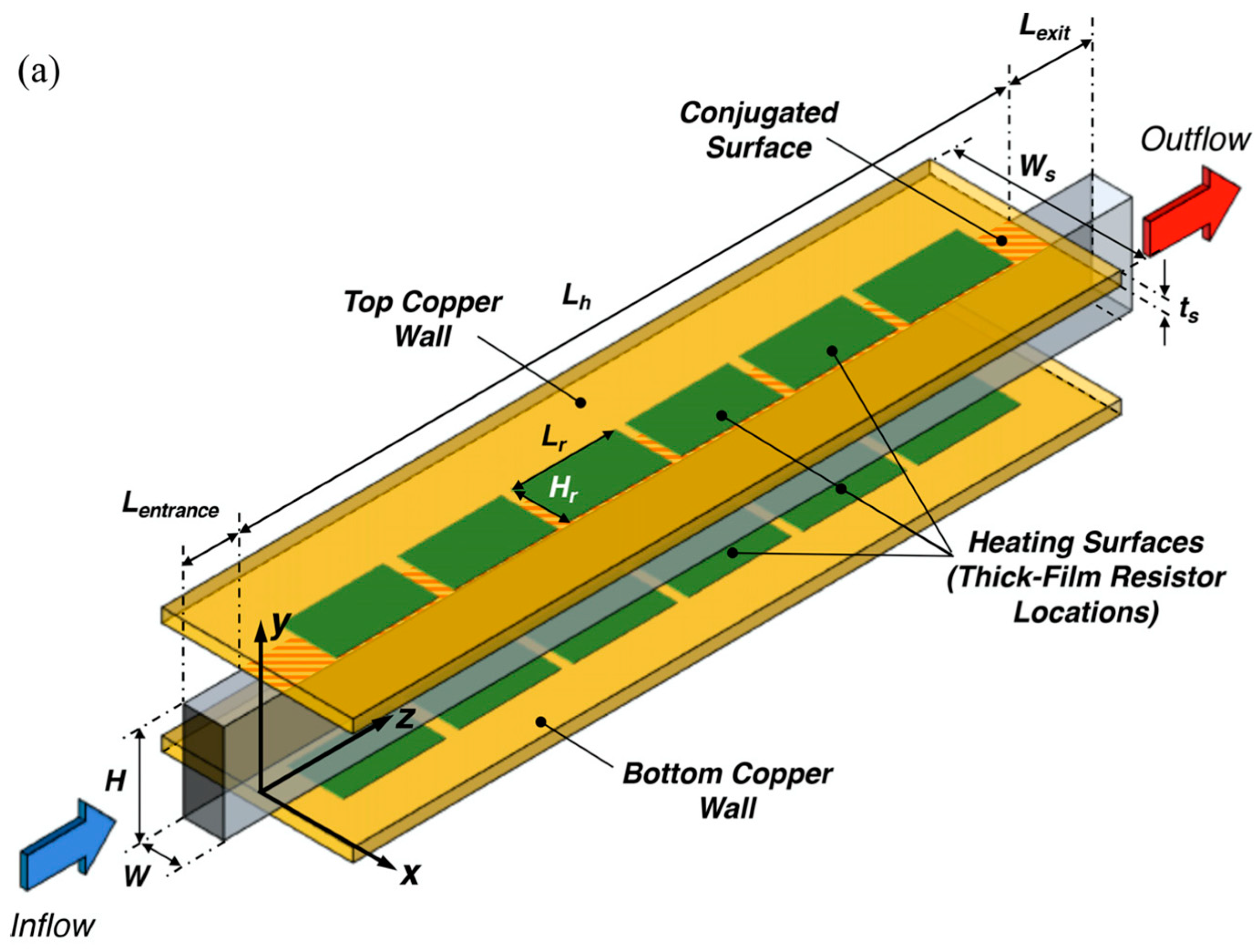

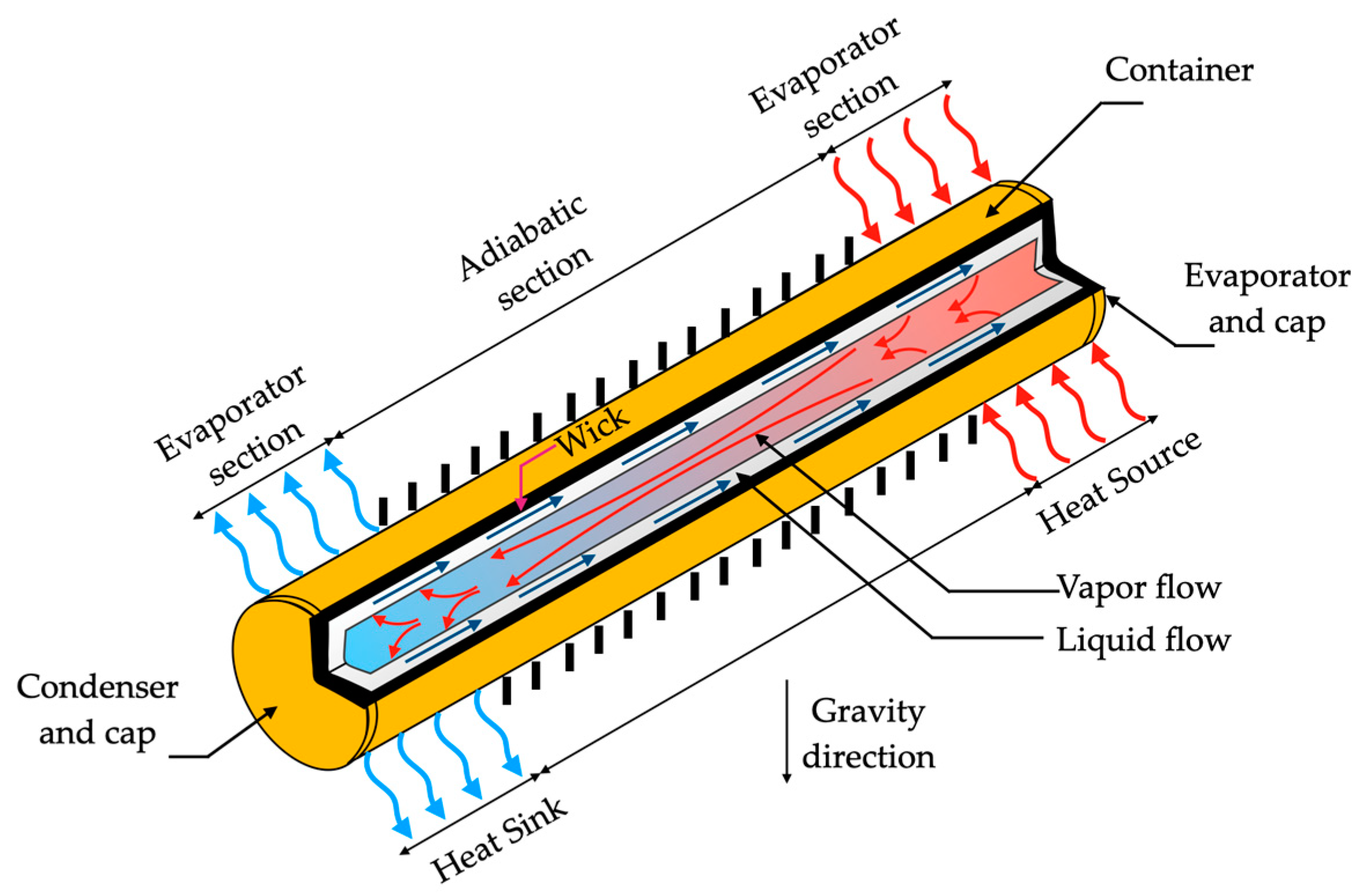

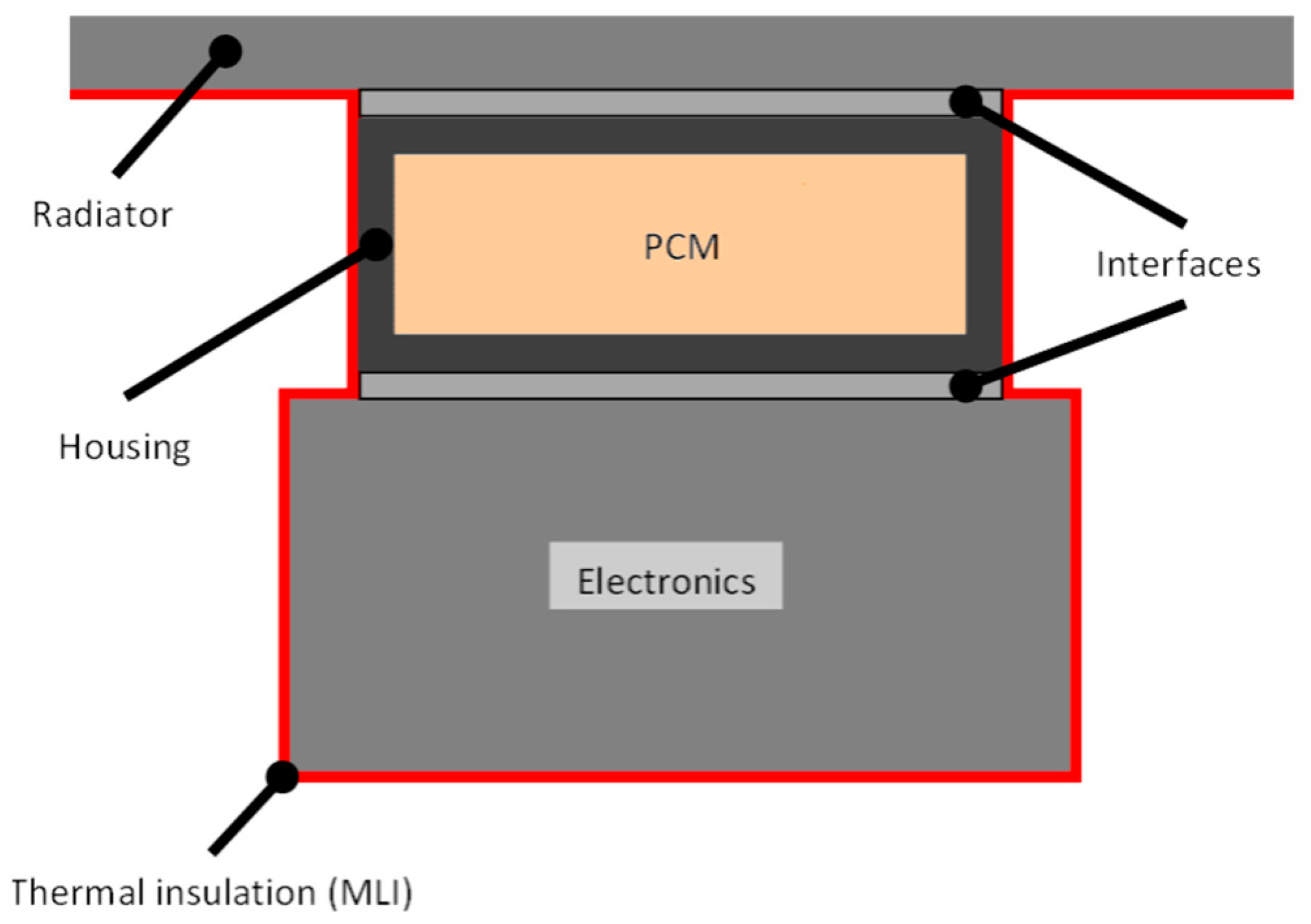
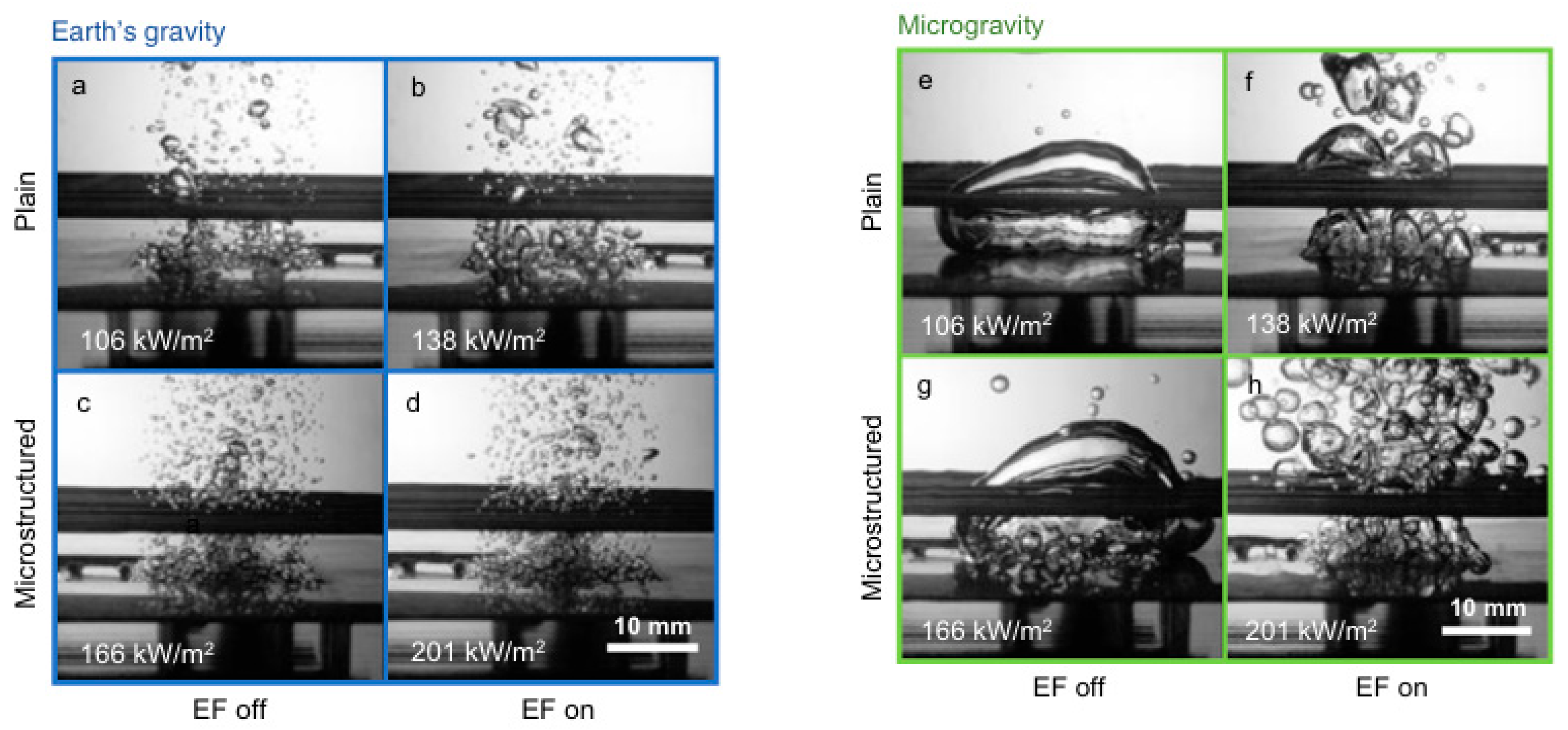
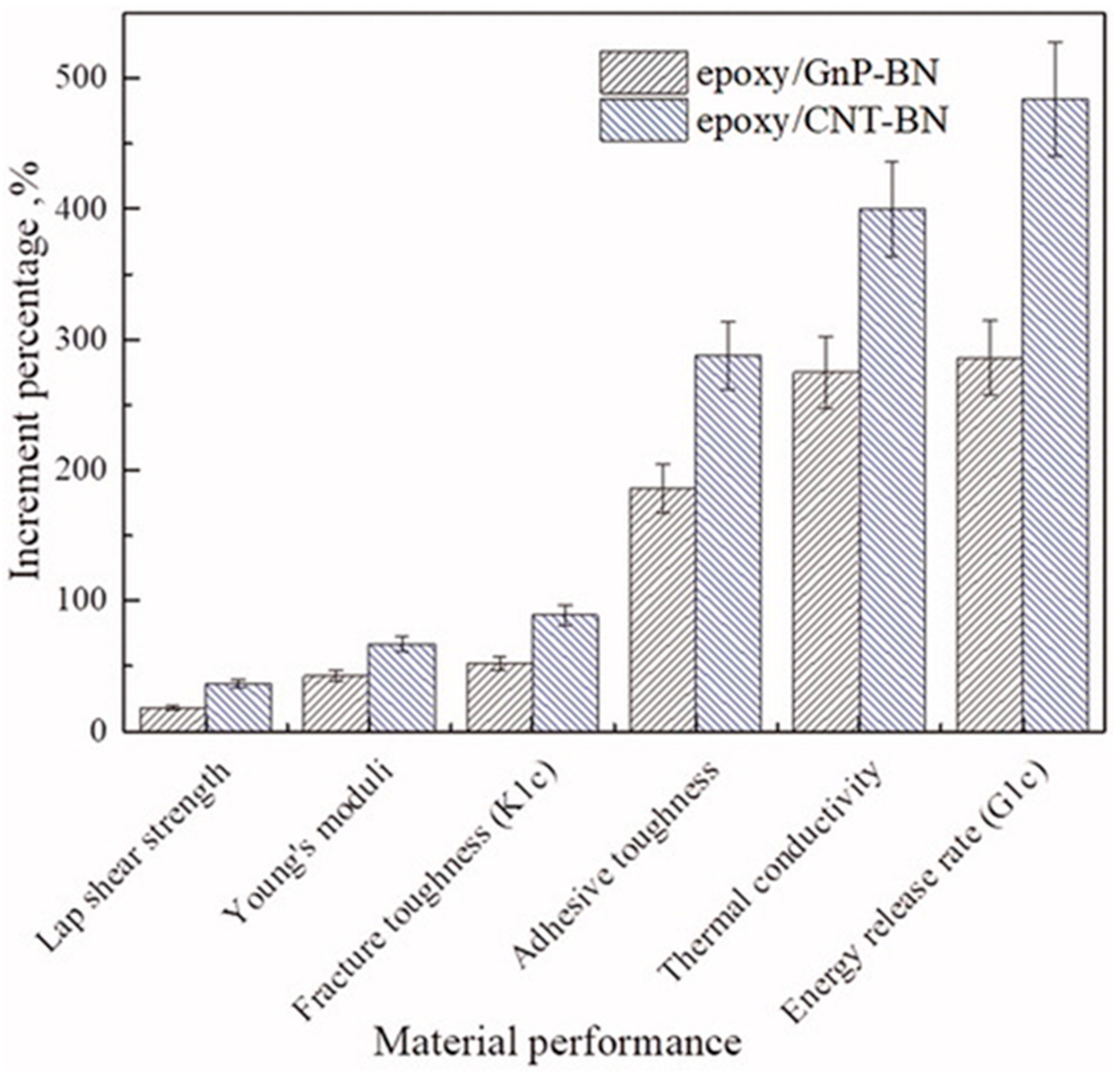
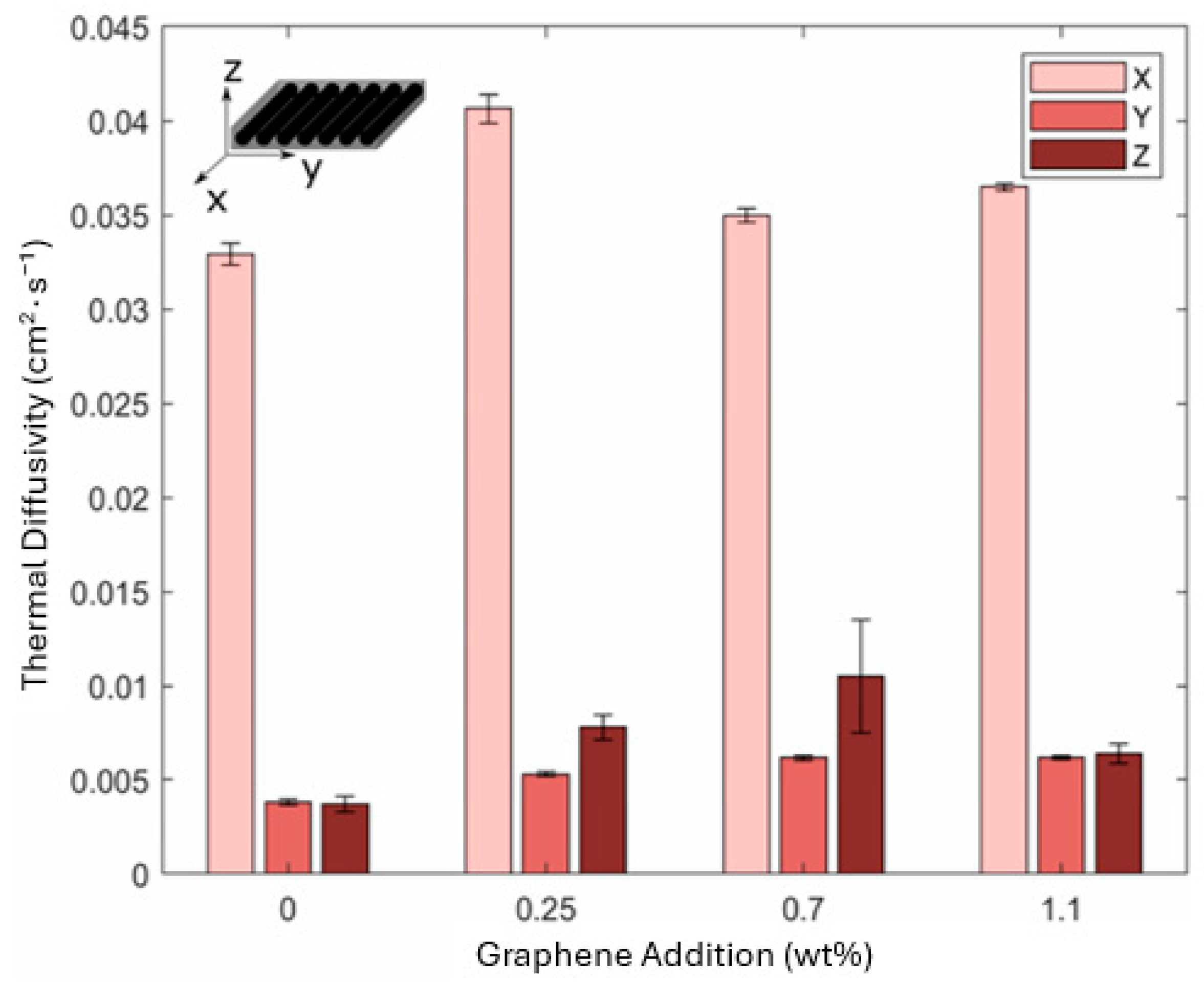
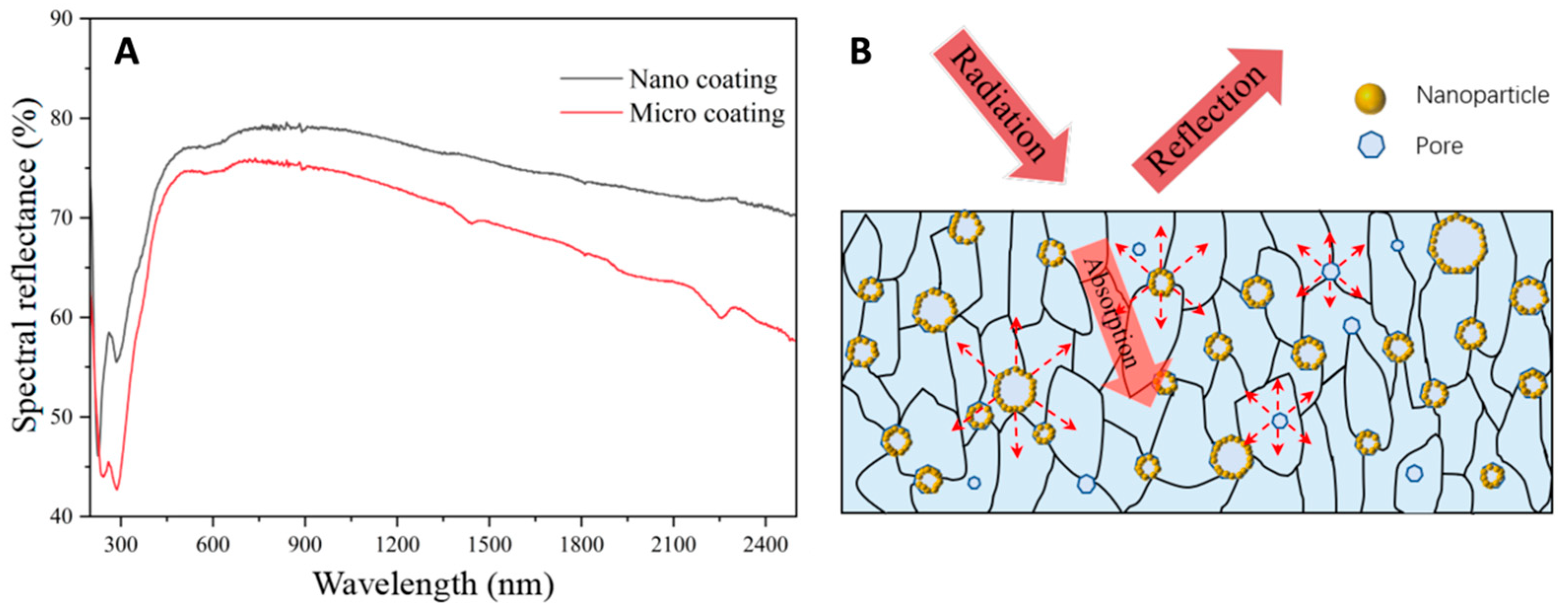
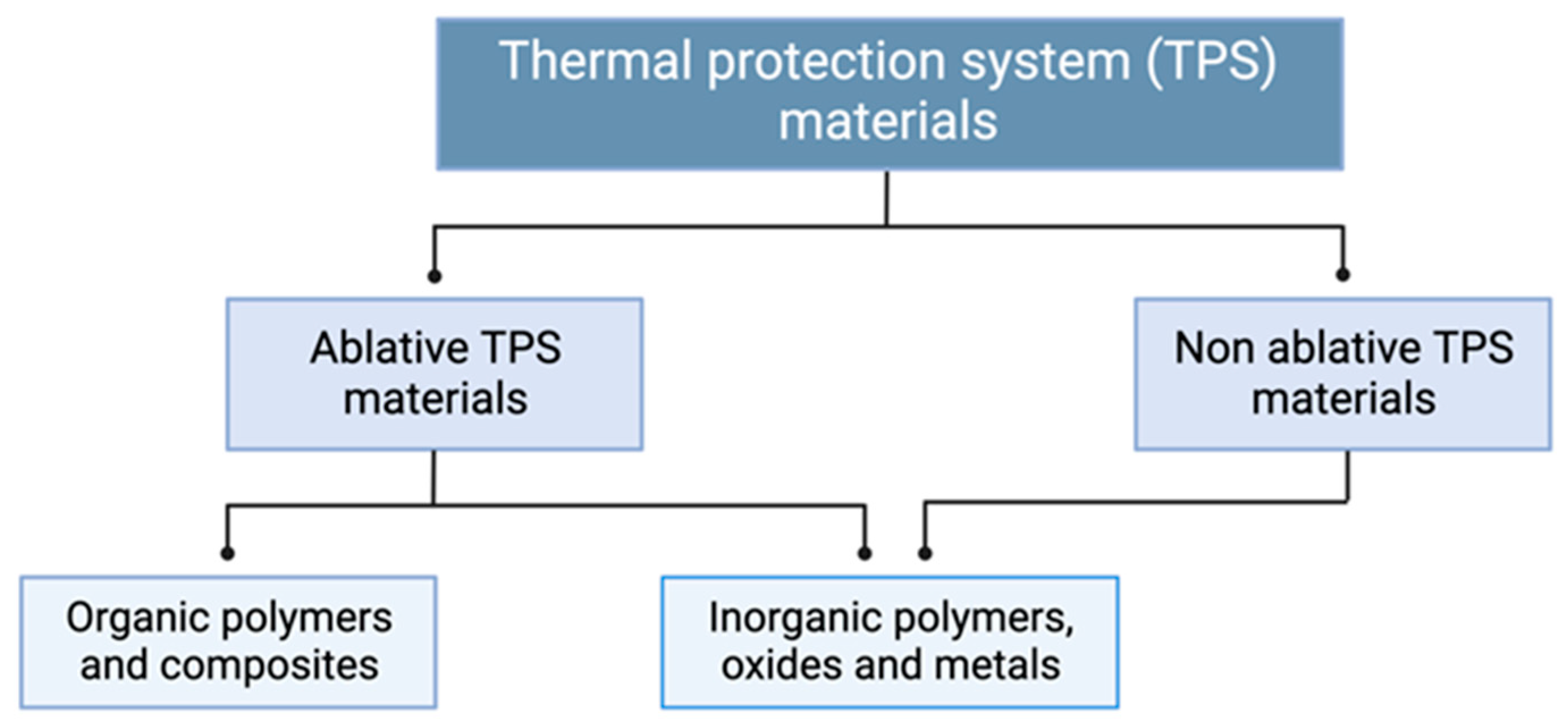
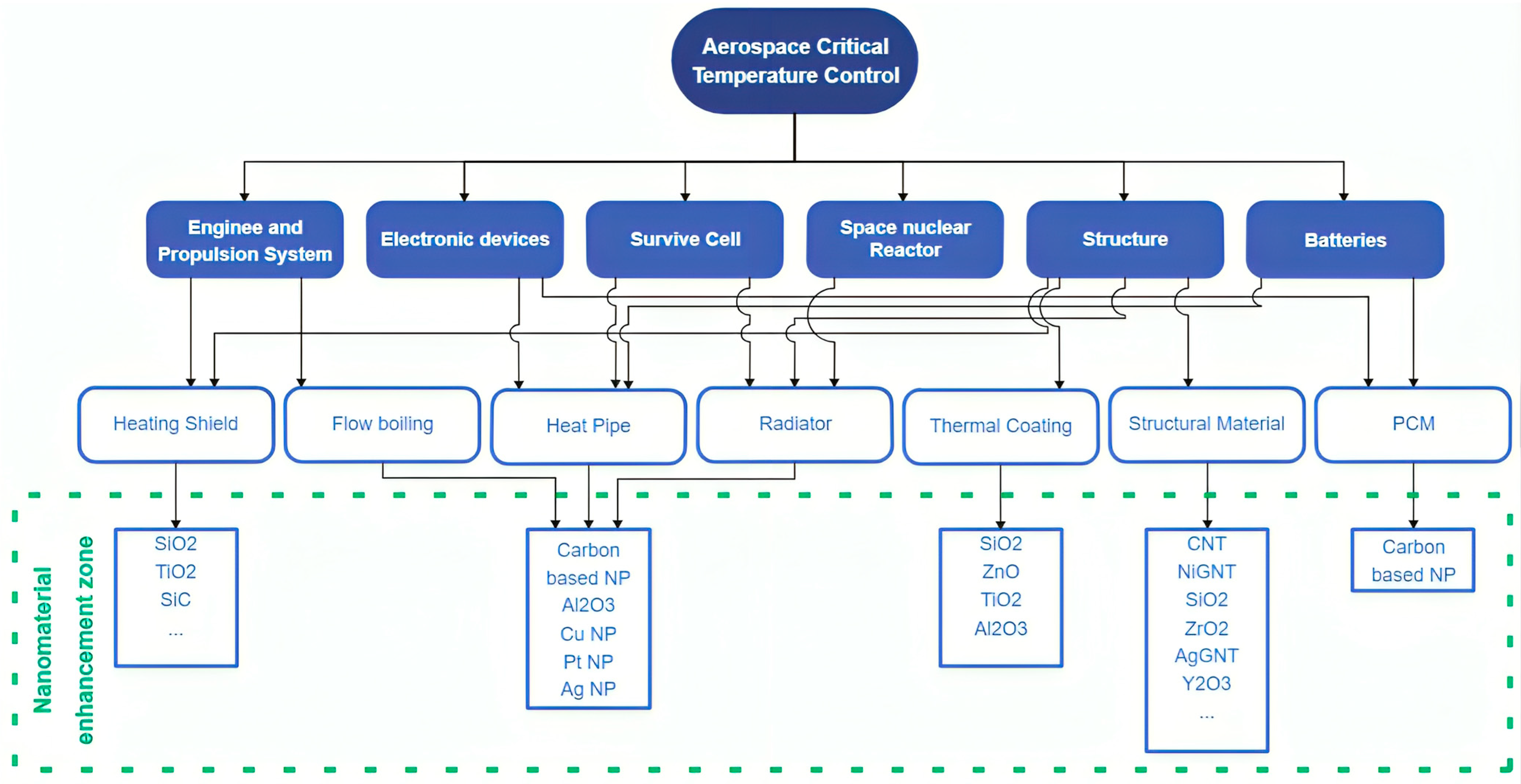
| Authors | Nanoparticles | Base Fluid | Concentration | Main Findings | Reference |
|---|---|---|---|---|---|
| Wu and Kumar | Alumina | Water | 1–5% vol. | The HTC and Nusselt number increased for all concentrations in comparison to those of water alone. The HTC at the maximum concentration was 9.1% and 9.7% higher than those of the water for expansion ratios of 1.9 and 3.5, respectively. The coefficient of skin friction and outlet temperature decreased for all concentrations. | [113] |
| Chen et al. | Graphene | Silicone oil | Up to 10% vol. | The thermal conductivity of the nanofluids increased with the growing concentration of graphene. Under these conditions, the temperature gradients at the two ends of the cavity decreased gradually, and the temperature gradient in the middle of the cavity augmented. In comparison with pure silicone oil, the Nusselt number of the graphene/silicone oil nanofluids with concentrations of 1, 2, 3, 4, 6, 8, and 10 vol.% decreased by 42.1%, 61.8%, 69.7%, 78.9%, 88.1%, 86.8%, and 92.1%, respectively. | [114] |
| Zhang et al. | Copper | Water | --- | The increasing strength of frequency of oscillation and incline angle led to reductions in the skin friction coefficient and HTC, but an opposite trend was found when the thermal buoyancy was enhanced. The increasing radius of the nanoparticles and frequency of oscillation led to a decrease in the skin friction and HTC, but an opposite trend was reported for the Nusselt number against the increasing radius. | [115] |
| Dong et al. | Alumina | Water | 0.07–0.1% vol. | The boiling HTC increased with increasing mass flow rates but decreased with an increase in the aspect ratio of the microchannels under terrestrial gravity and acceleration fields. The HTC under acceleration conditions was slightly smaller than that under terrestrial gravity. The HTC increased with increasing the concentration of nanoparticles for values up to 0.075 vol., but it decreased as the concentration increased from 0.07 vol.% to 0.1 vol.%. The impact of the acceleration magnitude and direction on the boiling heat transfer was noticeable. The HTC was reduced with increasing acceleration magnitudes. | [116] |
| Wu et al. | Platinum capped with hydrophobic hyperbranched polyglycerol | Methylcyclohexane | 23–33% wt. | The nanofluids were stable after a 180-day storage period. On a simulated cooling channel of aircraft, the cracking performance and the energy absorption capacity when using the nanofluids were promoted significantly. At 650 °C, the heat sink reached 2.39 MJ/kg with an increase of 20.7% in comparison to thermal cracking. Larger macroinitiators with hydrophobic hyperbranched polyglycerol were beneficial since to acquire the same heat sink of 2.20 MJ/kg, the temperature can be reduced from 675 °C to 664 °C, 653 °C, and 638 °C for the macroinitiators with molecular weights of 3 k, 5 k, and 13 k, respectively. | [117] |
| Hussain | Copper and copper and graphene oxide | Sodium alginate | --- | The copper–graphene oxide/sodium alginate hybrid nanofluid had higher thermal conductivity than that of the copper/sodium alginate nanofluid. The heat transfer rate increased with the growing concentration of nanoparticles. The entropy of the system was enhanced with increasing material factor, Reynolds number, thermal radiation factor, and concentration of nanoparticles. | [118] |
| Adnan et al. | Nanodiamond and silver | Water | Up to 0.2% vol. | The thermal conductivity of the silver/water nanofluids was higher than that of the nanodiamond/water nanofluid. The effective density and heat capacity increased with growing concentrations of the nanofluids. | [119] |
| Jamshed | Hybrid copper–silver and copper | Ethylene glycol | 0.09% and 0.18% vol. | The hybrid copper–silver/ethylene glycol nanofluid exhibited a higher heat transfer rate than that attained with the copper/ethylene glycol nanofluid. The thermal efficiency of the hybrid nanofluid surpassed the one of the mono nanofluid in between 2.6% and 4.4%. | [120] |
| Salawu et al. | Cobalt Ferrite–Copper | Ethylene Glycol | 0.09% vol., 0.15% vol., and 0.18% vol. | The cobalt ferrite–copper/ethylene glycol nanofluid had higher thermal conductivity than the copper–ethylene glycol nanofluid. The energy optimization of the system was enhanced with increasing concentrations of nanoparticles. The heat transmission amount was strongly increased with increasing sizes of the nanoparticles. | [121] |
| Jamshed et al. | Hybrid copper–silica and copper | Ethylene glycol | --- | The heat transmission was enhanced because of the amplification of thermal radiative flow and variant thermal conductivity. The hybrid nanofluid exhibited better heat transmission capability. The thermal efficiency of the copper–silica/ethylene glycol nanofluid was higher than that of the copper/ethylene glycol nanofluid in between 0.2% and 3.9%. | [122] |
| Matrix | Nanoparticle Type | Application | Ref. |
|---|---|---|---|
| Li2SiO3 + ZnO | SiO2 | Thermal control | [64] |
| Carbon/carbon | SiO2 | Improved stability at high temperatures | [85] |
| Acrylic resin | TiO2 | Improved passive radiative cooling performance | [90] |
| SiO2 | ZnO QDs | Thermal control | [6] |
| Alumina | Al2O3 | Thermal control | [103] |
| Resole-based phenolic resin, carbon–phenolic composite, and polymer matrix composite | Carbon nanotubes, nano-diamonds, graphene oxide, ZrSi2, cenosphere, and nano-SiO2 | Thermal protection | [82] |
| SiO2 | Ag | Lightweight, flexible pressure sensor | [87] |
| Cu-Cr-Y alloy | Y2O3 and Cr | Heat dissipation | [86] |
| Siliconoxycarbide–phenolic-interpenetrating aerogel | SiO2, ZrSi2, and ZrB2 | Thermal protection | [98] |
| Epoxy resin | Graphene nanoplatelets and carbon nanotubes | Enhanced mechanical and electrical carbon fiber composite | [123] |
| Epoxy resin | Graphene oxide–carbon nanotubes nanostructures decorated with nickel nanoparticles (NiGNTs) | Spacecraft structures | [91] |
| Poly(ether ether ketone) (PEEK) | Ag nanoparticles-decorated GO/CNT (AgGNT) | Critical aerospace applications and advanced structural composites | [91] |
| SiCN aerogel | TiO2 nanorods | High-temperature, high-strength, lightweight spacecraft-insulating systems | [11] |
| Silica aerogel with aluminum Sol-Al(H2PO4)3 | Hydroxyapatite (HAP) nanowires | Thermal protection | [10] |
| Jute/thermoplastic starch (TPS) | Nano-silica particles | Thermal protection | [96] |
| Carbon fiber/PEEK | Graphene | Thermal control | [8] |
| Epoxy resin | Sulfonated SiO2 | Spacecraft structures | [92] |
| Epoxy resin | SiO2 and ZrO2 | Honeycomb structures | [93] |
| Epoxy and Kevlar 29 | SiC and TiO2 | Increase flame resistance | [97] |
| Epoxy resin | Graphene platelet and carbon nanotube with boron nitride nanosheet | Thermal control and electric conductivity | [9] |
Disclaimer/Publisher’s Note: The statements, opinions and data contained in all publications are solely those of the individual author(s) and contributor(s) and not of MDPI and/or the editor(s). MDPI and/or the editor(s) disclaim responsibility for any injury to people or property resulting from any ideas, methods, instructions or products referred to in the content. |
© 2024 by the authors. Licensee MDPI, Basel, Switzerland. This article is an open access article distributed under the terms and conditions of the Creative Commons Attribution (CC BY) license (https://creativecommons.org/licenses/by/4.0/).
Share and Cite
Nobrega, G.; Cardoso, B.; Souza, R.; Pereira, J.; Pontes, P.; Catarino, S.O.; Pinho, D.; Lima, R.; Moita, A. A Review of Novel Heat Transfer Materials and Fluids for Aerospace Applications. Aerospace 2024, 11, 275. https://doi.org/10.3390/aerospace11040275
Nobrega G, Cardoso B, Souza R, Pereira J, Pontes P, Catarino SO, Pinho D, Lima R, Moita A. A Review of Novel Heat Transfer Materials and Fluids for Aerospace Applications. Aerospace. 2024; 11(4):275. https://doi.org/10.3390/aerospace11040275
Chicago/Turabian StyleNobrega, Glauco, Beatriz Cardoso, Reinaldo Souza, José Pereira, Pedro Pontes, Susana O. Catarino, Diana Pinho, Rui Lima, and Ana Moita. 2024. "A Review of Novel Heat Transfer Materials and Fluids for Aerospace Applications" Aerospace 11, no. 4: 275. https://doi.org/10.3390/aerospace11040275







